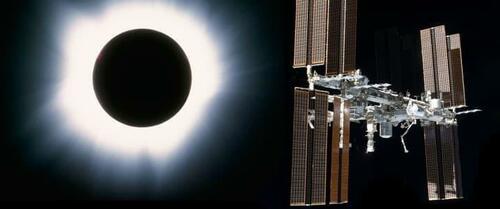The Race For Solar Power From Space Is On
Authored by Tsvetana Paraskova via OilPrice.com,
-
A public-private Japanese partnership plans tests to beam space-generated solar power back to earth.
-
The cost to install massive solar panels in space to generate 1 gigawatt (GW) of electricity is expected to cost more than $7.2 billion
-
China also has ambitious plans to build a solar power station in space at a GW-level
In the latest ambitious project to use solar energy in space for powering the earth, a public-private Japanese partnership plans to test as soon as in 2025 if solar power generated in space can be beamed to the earth and converted into electricity.
The Japanese venture is the latest in a series of plans and experiments in recent months to test if solar power converted into microwaves could be beamed to receiving stations on the earth’s surface for large-scale use.
Scientists and science fiction writers have long dreamed of such a solar energy source: harnessing the sun’s energy regardless of weather or the time of day or night. This would overcome the constraints for solar power on earth, where generation can take place only when the sun shines. In addition, microwaves can pass through clouds, so beaming the energy via microwaves to the earth would not pose limits to solar energy due to weather conditions or the time of day.
The limits, of course, are the technology to do this at mass scale and the costs.
The cost to install massive solar panels in space to generate 1 gigawatt (GW) of electricity is expected to cost more than $7.2 billion (1 trillion Japanese yen), Nikkei Asia reports.
Still, researchers led by Kyoto University professor Naoki Shinohara will try to beam solar power to Earth to potentially prove that solar energy harnessed in space can be used for electricity needs on Earth.
Japan’s project involving industry, scientists, and the government space agency carried out successful tests of microwave power transmission horizontally in 2015 and vertically in 2018, both over a distance of 50 meters (164 ft). Vertical transmission with distances between 1 km and 5 km (0.62-3.1 miles) will be attempted in the future.
“If we can demonstrate our technology ahead of the rest of the world, it will also be a bargaining tool for space development with other countries,” Shinohara told Nikkei.
The race for generating solar power in space and beaming it back to Earth is heated.
More than two years ago, the Pentagon successfully tested a solar panel in low-earth orbit as a prototype of potential future power-generating systems capturing light from the sun and beaming it back as energy to Earth.
Early this year, the Caltech Space Solar Power Project (SSPP) launched the Transporter-6 mission, launching in orbit a prototype, dubbed the Space Solar Power Demonstrator (SSPD), which will test several key components of an ambitious plan to harvest solar power in space and beam the energy back to Earth.
“When fully realized, SSPP will deploy a constellation of modular spacecraft that collect sunlight, transform it into electricity, then wirelessly transmit that electricity over long distances wherever it is needed—including to places that currently have no access to reliable power,” Caltech said in January.
China also has ambitious plans to build a solar power station in space at a GW-level, which will make the project operational for commercial use, Chinese experts told the Global Times in April.
Also in April, the European Space Agency (ESA) signed contracts for two parallel concept studies for commercial-scale Space-Based Solar Power plants—a crucial step in the Agency’s new SOLARIS initiative – maturing the feasibility of gathering solar energy from space for terrestrial clean energy needs.
“The studies will look at as wide a range of options as possible, including investigating all the different ways to move the energy, safely and efficiently, down to Earth: radio frequency transmission, lasers and simply reflecting sunlight down to solar farms on the ground,” said Sanjay Vijendran, ESA’s lead for the SOLARIS proposal.
According to ESA, “the concept complements rather than competes with terrestrial renewables, because Space-Based Solar Power can make power available reliably on an ongoing 24/7 basis, providing much-needed stability to the electricity grid as the share of intermittent renewables continues to increase, reducing dependence on large-scale storage solutions.”
With the energy crisis, net-zero targets, and issues with land availability for renewable power installations, space solar power could be part of the solution in the future, if technology and costs allow for it.
Tyler Durden
Fri, 06/02/2023 – 05:00
via ZeroHedge News https://ift.tt/Zb1UCrQ Tyler Durden
